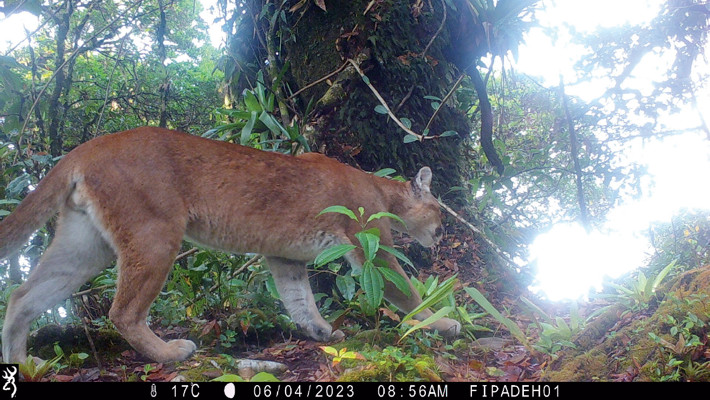First photographic record of puma Puma concolor in the Misoco Biological Reserve, Honduras
DOI:
https://doi.org/10.31687/SaremNMS24.08.3Keywords:
conservation, distribution, Felidae, monitoring, protected areasAbstract
The puma Puma concolor (Linnaeus, 1771) is the second largest feline in Honduras. Its presence in the country has already been documented for six protected areas through the use of camera traps. Worldwide, according to the Red List of Threatened Species of the International Union for Conservation of Nature (IUCN), the puma is categorized as Least Concern; however, in Honduras these felines are threatened by habitat loss and growth of urbanizations, placing them under the category of Endangered. In this work we report the presence of the puma, through photographic evidence, in the Misoco Biological Reserve (RBM).
References
Campbell, M., & M. Torres. 2011. Public perceptions of jaguars Panthera onca, pumas Puma concolor and coyotes Canis latrans in El Salvador. Área 43:250–256. https://doi.org/10.1111/j.1475-4762.2011.00996.x.
Cruz-Miranda, Y., S. Ugalde-Lezama, L. Tarango-Aránbula, O. Rosas -Rosas, J. Buendía-Espinoza, & E. Lozano-Cavazos. 2017. Modelo alternativo para determinar coexistencia y segregación trófica de dos felinos simpátricos: Puma concolor L. y Panthera onca L. Agroproductividad 10:18–27.
Gonthier, D., & F. Castañeda. 2013. Large-and medium-sized mammal survey using camera traps in the Sikre River in the Río Plátano Biosphere Reserve, Honduras. Tropical Conservation Science 6:584–591. https://doi.org/10.1177/194008291300600409.
Labarge, L., M. Evans, J. Miller, G. Cannataro, C. Hunt, & L. Elbroch. 2022. Pumas Puma concolor as ecological brokers: a review of their biotic relationships. Mammal Review 52:360–376. https://doi.org/10.1111/mam.12281.
Midence, S. 2019. Registro del puma (Puma concolor) en el Parque Nacional Azul Meámbar, a través del uso de trampas cámaras. Scientia Hondurensis 2:5–8.
Negrões, N., et al. 2010. Use of Camera-trapping to estimate puma density and influencing factors in Central Brazil. Journal of Wildlife Management 74:1195–1203. https://doi.org/10.1111/j.1937-2817.2010.tb01240.x.
Nielsen, C., D. Thompson, M. Kelly, & C. Lopez-Gonzalez. 2015. Puma concolor. The IUCN Red List of Threatened Species 2015: e.T18868A97216466. http://doi.org/10.2305/IUCN.UK.2015-4.RLTS.T18868A50663436.en.
Portillo, H., & F. Elvir. 2013. Distribución de felinos en áreas naturales protegidas de Honduras. Revista Mexicana de Mastozoología (Nueva Época) 3:1–10. https://doi.org/10.22201/ie.20074484e.2013.3.1.173.
Portillo, H., & F. Valle. 2022. Datos preliminares de los registros de puma (Puma concolor) y su posible distribución en Honduras. Revista Mexicana de Mastozoología (Nueva Época) 12:22–32. https://doi.org/10.22201/ie.20074484e.2022.12.1.351.
Wildlife Conservation Society (WCS). 2021. Lista Roja de especies amenazadas de Honduras. Tegucigalpa, M.D.C., Honduras.

Downloads
Published
How to Cite
Issue
Section
License
Copyright (c) 2024 Lourdes M. Alvarado, Alejandra S. Martinez, Daniela N. Sorto, Luis G. Zúniga

This work is licensed under a Creative Commons Attribution-NonCommercial 4.0 International License.

